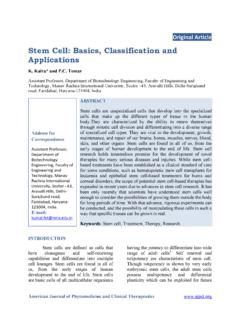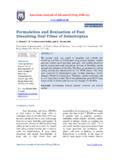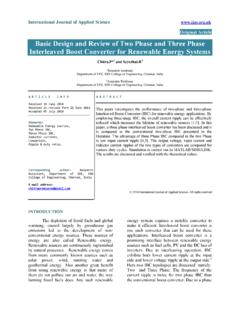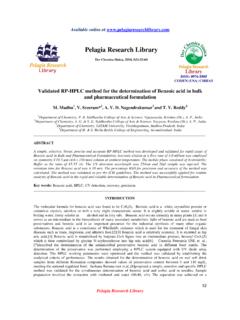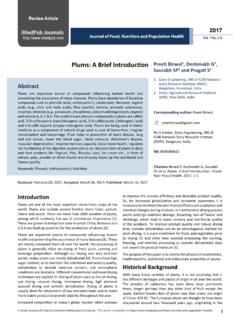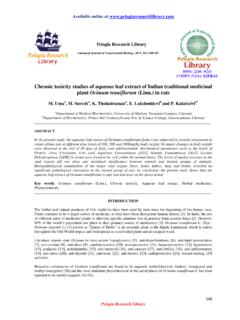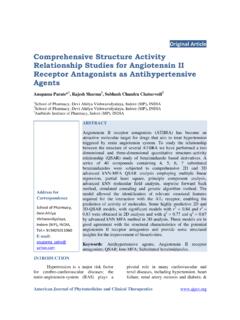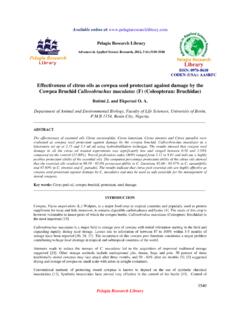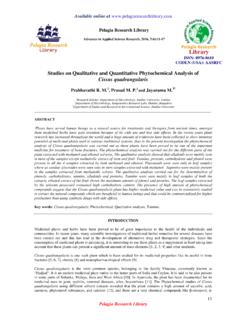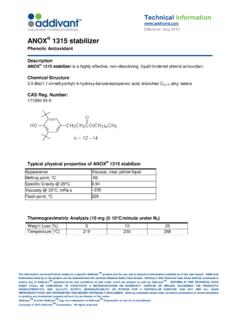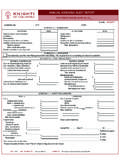Transcription of Factors influencing utilization of antenatal care services ...
1 Available online at Pelagia Research Library Advances in Applied Science Research, 2012, 3 (3):1309-1315 ISSN: 0976-8610 CODEN (USA): AASRFC 1309 Pelagia Research Library Factors influencing utilization of antenatal care services among pregnant women in Ife Central Lga, Osun State Nigeria *Onasoga, Olayinka , Afolayan, Joel A1 and Oladimeij, Bukola 1 Faculty of Nursing, Niger Delta University, Wilberforce Island, Bayelsa State, Nigeria 2 National Hospital Abuja, Nigeria _____ ABSTRACT antenatal care is a key strategy for reducing maternal and neonatal morbidity and mortality rate because adequate utilization of antenatal health care services is associated with improved maternal and neonatal health outcomes. This study aimed at determining the Factors influencing the utilization of antenatal clinic among pregnant women in Ife Central Local Government Area, Osun State, Nigeria. Stratified sampling technique was used to select 102 pregnant women from Ife Central Local Government Area of Osun State, Nigeria.
2 Data were collected using a questionnaire. Both descriptive and inferential statistics were used to analyze the data generated and level of significance was set at 5% ( ). The findings revealed that majority of the respondents 48 ( ) first heard of ANC in the hospital. Most of the respondents 85( ) knew the services rendered at antenatal clinic and had adequate knowledge of the importance of antenatal care . The findings also revealed that majority of the respondents 58 ( %) attend ANC regularly; 56( ) booked for antenatal care in the first trimester; and attend on appointment days after booking. The study also showed that majority of the respondents opined that affordability of antenatal services , schedule of ANC, lack of knowledge about the existing services in ANC and Husband's acceptance of the services rendered as the major Factors influencing its utilization . The findings also revealed that there was significant association between knowledge, distance, marital status, religion and level of education of respondents under study and their utilization of ANC services with p<.
3 On the other hand no significant association was found between parity and occupation of respondents under study and their utilization of ANC services with P> Key Words: Factors , utilization , antenatal care , Pregnant Women. _____ INTRODUCTION The United Nations estimates that 529 000 women die each year from complications during pregnancy and childbirth [AbouZahr & Wardlaw, 2004]. In Nigeria, it is estimated that approximately 59,000 of maternal deaths take place annually as a result of pregnancy, delivery and post delivery complications [WHO, UNICEF, UNFPA, 2007] despite the available antenatal health care services . A Nigerian woman is 500 times more likely to die in childbirth than her European counterpart. Mortality ratio is about 800- 1,500/100,000 live births with marked variation between geo-political zones- 165 in south west compared with 1,549 in the North- east and between urban and rural areas [NDHS, 2003; NPC, 2008].
4 Each year, about 6 million women become pregnant; 5 million of these pregnancies result in child birth [WHO, UNICEF, UNFPA, 2007]. antenatal care refers to the care that is given to an expectant mother from the time that Onasoga, Olayinka A. et al Adv. Appl. Sci. Res., 2012, 3(3):1309-1315 _____ 1310 Pelagia Research Library conception is confirmed until the beginning of labor [Viccars, 2003]. Adequate utilization of antenatal health care services is associated with improved maternal and neonatal health outcomes. antenatal care is expected to have impact on the development of the fetus and the infant as well as mother and this can only be achieved through early booking and regular attendance of antenatal clinic. The trend of maternal mortality in developing countries has been increasing and various international organizations have reported that an important factor related to maternal and infant mortality has been linked to lack of antenatal care [Villar, et al.]
5 2001]. According to Federal Ministry of Health [2005], some of the dangers of pregnancy and childbirth can be avoided if the pregnant woman attends antenatal regularly. In order to decrease these mortality rates, regular antenatal care has to be instituted or reinforced which can only be achieved through identifying Factors causing poor utilization of antenatal care services . According to WHO [2001] only 60% of women receive antenatal care in Nigeria, and not all of them attend the antenatal clinic regularly [Villar et al., 2001]. A study reported that with maternal risk held constant, low birth weight, and infant mortality were times higher with late and less frequent antenatal care than with early and frequent care [Quick, Greenwick & Reghman, 1991]. A study carried out on reproductive health issues showed that in 69% of the recorded births, the mothers made 4 or more antenatal visits, while 20% made fewer than 4 visits and did not attend at all which is contrary to WHO recommendation of 12 visits [Villar et al.
6 , 2001]. This shows that there are marked differential in the use of antenatal and same as been observed in Ife Central Local Government Area of Osun State Nigeria. Thus giving rise to the need to identify the Factors influencing the utilization of antenatal clinic among pregnant women in Ife Central LGA, Osun State Nigeria Specific Objective To understand the trend of utilization of antenatal care services by pregnant women in Ife Central local government area, Osun State. To assess the level of knowledge of pregnant women about antenatal care services in Ife Central local government area. To determine the Factors influencing the utilization of antenatal care services among pregnant women in Ife Central local government area. Null Hypothesis There is no significant difference between distance/proximity of ANC clinic to residence of pregnant women under study and the utilization of ANC services .
7 There is no statistically significant association between socio-demographic characteristics of pregnant women and their utilization of ANC services . There is no significant difference between the knowledge of pregnant women under study and their utilization of ANC services . Significant of Study This study will enable the health care professional to determine the Factors causing poor or irregular utilization of antenatal care services and how to eradicate it. It will also help the government to develop and implement new policies towards encouraging proper utilization of antenatal care services , which will help to reduce maternal and neonatal morbidity and mortality rates, Research Methodology A descriptive research design was used and the study setting was Ife Central Local Government Area in Osun State, Nigeria. It is an urban area with many ancient infrastructure and various cadres of people reside in Ife Central Local Government Area with different religion, cultural background, level of education and ethnicity.
8 The target population were all pregnant women in Ife Central Local Government Area of Osun State, Nigeria. Stratified sampling technique was used to select 102 pregnant women in Ife Central Local Government Area of Osun State, Nigeria. The instrument for data collection was self developed questionnaire which was divided into sections relevant to the objectives of the study. Informed consent of the respondents was sought and the purpose of the study was explained to the respondents. Information provided by the respondents was treated confidentially and respondents anonymity was maintained. The necessary translation of the contents of the questionnaire was given to the women for proper understanding. The data obtained was analyzed using statistical package for social sciences Onasoga, Olayinka A. et al Adv. Appl. Sci. Res., 2012, 3(3):1309-1315 _____ 1311 Pelagia Research Library (SPSS) for windows Both descriptive and inferential statistics were used to analyze the data collected and level of significance was set at 5% ( ) such that significant associations were established when p < RESULTS Table 1 Frequency Distribution of Demographic Data of Respondents (n=102) DEMOGRAPHIC VARIABLES FREQUENCY(N) PERCENTAGE (%) AGE(Years) 15-24 25-34 35-44 31 38 33 OCCUPATION Civil servant Personal business Housewife 48 34 20 RELIGION Christianity Islam Traditional 55 41 6 MARITAL STATUS Married Single Divorced 69 21 12 EDUCATIONAL QUALIFICATION No formal education Primary school or below Secondary school Tertiary institution 20 33 27 22 AVERAGE INCOME PER MONTH(Naira) 10,000 and below 10,000-50,000 50,000-above 32 47 23 Parity (Children) Below 3 4 5 and above 74 18 10 Table 1 shows that majority of the respondents 38 ( )
9 Were between 25-34 years, while 33 respondents ( ) were between 35-44 years and 31 respondents ( ) were between 15-24 years. 55 ( ) were Christian, 41 ( ) were Islam and the remaining 6 ( ) were traditionalist. Most of the respondents 48 ( ) were civil servant, while 34 ( ) have personal business and the remaining 20 ( ) were full housewives. 69 ( ) of the respondents were married, 21 ( ) single while 12 ( ) were divorced. Majority of the respondents 33 ( ) had primary school education, while 27 ( ) had secondary school and 22 ( ) had tertiary institution. 20 ( ) had no formal education. Majority of the respondents 74 ( ) had below 3 children, 18 ( ) had 4 children and 10 ( ) had 5 children and above Table 2 Frequency Distribution of Respondents on Knowledge of antenatal care (n=102) Knowledge variable Frequency (n) Percentage (%) You First Heard of ANC Through Friends School Hospital Others 15 21 48 18 Do you know the services rendered at antenatal clinic Yes No 85 17 antenatal care helps detect complications during pregnancy Yes No 84 18 antenatal care helps to reduce maternal and neonatal morbidity and mortality Yes No 81 21 Onasoga, Olayinka A.
10 Et al Adv. Appl. Sci. Res., 2012, 3(3):1309-1315 _____ 1312 Pelagia Research Library Table 2 shows that majority of the respondents 48 ( ) first heard of ANC in the hospital, 21( ) in school, 15 (14:7%) through friends while 18 ( ) heard of it through other means. 85( ) of the respondents knew the services rendered at antenatal clinic, while 17 ( ) does not. Majority of the respondents 12:84( ) agreed that attendance of ANC helps detect possible complications during pregnancy while 18 ( ) answered no to this question. 81( ) said that antenatal care helps to reduce maternal and neonatal morbidity and mortality while 21( ) said otherwise. Table 3 Frequency Distribution of Respondents Showing utilization of ANC (n=102) variables Response Frequency Percentage Do you attend ANC regularly Yes Sometimes Never attended 58 40 4 *Proximity of ANC Walking distance One bus Two or more buses 30 52 16 *Booking 1-3 months(first trimester) 4-6months(second trimester) 7-9 months(third trimester) 56 25 17 Pattern of attendance of ANC after booking Appointment days When I have complaints I do not go at all 65 33 4 Working days/days of the week Throughout the week Only week days Do not go to work at all any time 35 37 20 10 Working time (time of the day) In the morning Throughout the day Any time I like Do not work 31 20 31 20 Attendance Time of antenatal clinic In the morning Anytime I want Not at all 85 13 4 *98 respondents were used since 4 respondents did not attended antenatal clinic at all Table 4.

